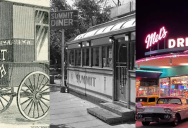The History Of The Diner, Who Created The First One And Why Diners Flourished In America
by Ethan Cotler
The American diner is seen as a second home for many.
Its welcoming doors are often open 24 hours a day, providing food, camaraderie, and comfort at any odd hour.
Whether you’re clocking out from late-night shift work or getting early-morning pancakes, these timeless establishments have seemingly always been there to help.
So let’s dive into some of the history of the diner, and explain why they still are popular across the world today!

Walter Scott: The father of the American diner
The diner’s humble beginnings can be traced back to an unassuming pressman moonlighting as an entrepreneur in Providence, Rhode Island, around 1858.

His name was Walter Scott, and he initially sold sandwiches and coffee from a basket to cater to newspaper night workers and men’s club patrons.
He eventually quit his printing job due to the lucrative nature of his side business and began vending food from a horse-drawn wagon.
The birth of the “lunch wagon”
In its initial days, “diner” was synonymous with modest eateries boasting limited menus that catered mainly to industrial workers in need of quick and cheap meals.
These primitive diners were usually housed in small food trailers or repurposed train cars strategically located near burgeoning urban areas.
Also, the word diner wasn’t used until later. At this point in the diner’s history, they were called lunch wagons.

The appeal of these lunch wagons are obvious. They’re highly mobile so they can move to where people need to eat.
People like C.H. Palmer spotted this trend and started manufacturing lunch wagons for sale or rent. Enhanced versions allowed customers to stand inside, sheltered from harsh weather conditions, or perch on stools at counters.

These “Nite Owls,” as they were fondly called, became popular fixtures across New England towns during the late 1800s–when most places closed at 8 PM.
The diner finally plant roots thanks to Jerry Mahoney
As time passed, these lunch cars evolved into permanent establishments with larger counters, tiles, bathrooms, and smaller wheels.

Jerry Mahoney established the first static diner in 1913, owning companies that shipped diners across the country.

By the 1950s, his Jerry O’Mahony Diner Company hold sold over 2,000 of these diners nationwide and they took on the iconic look that most of us recognized as what many consider a diner in modern times.

Less than 20 of these remain across the United States today, so if you see one you shouldn’t definitely take a picture next time and capture a bit of history for yourself.
Diners evolved over time into what they are today
The onset of World War I saw diners shifting their target demographic to women by adding homey touches like flower boxes and wallpaper.
The streamlined design featuring bullet-shaped exteriors and chrome interiors came about in the 1930s as an attempt to modernize their image while reflecting the times’ futuristic aesthetic.

Diners held strong through the Depression owing to their low-cost menus. Demand spiked post-World War II when returning servicemen and women sought familiarity in these establishments.
Recently, retro-looking diners have seen an increase in popularity. The aesthetic is even favored in Europe, giving much-needed support to American diner companies.
The diner’s cultural influence is undeniable–from films like Pulp Fiction and When Harry Met Sally to TV series like Twin Peaks, where detectives often stopped at local diners.

American diners continue to be popular among people from all walks of life–workers, families, students, seniors–thanks to its affordable prices and mouth-watering food options.
This home away from home for many continues to be a testament to America’s diverse culture as they serve up comfort food while reflecting regional flavors on their menus.
Categories: HISTORY, STORIES
Tags: · c.h. palmer, diner, food, history, jerry mahoney, lunch wagons, restaurant, restaurants, single topic, top, walter scott

Sign up to get our BEST stories of the week straight to your inbox.




